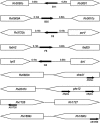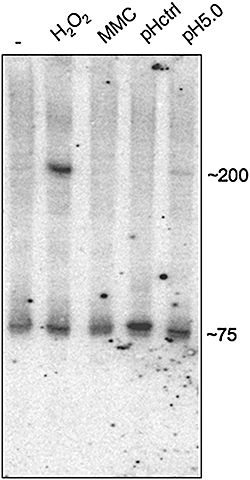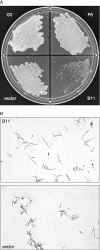Identification of small RNAs in Mycobacterium tuberculosis
- PMID: 19555452
- PMCID: PMC2764107
- DOI: 10.1111/j.1365-2958.2009.06777.x
Identification of small RNAs in Mycobacterium tuberculosis
Abstract
In spite of being one of our most prominent bacterial pathogens, the presence of small regulatory RNAs (sRNAs) has not previously been investigated in Mycobacterium tuberculosis. Post-transcriptional regulation of gene expression by sRNA molecules has been demonstrated in a wide range of pathogenic bacteria and has been shown to play a significant role in the control of virulence. By screening cDNA libraries prepared from low-molecular weight RNA from M. tuberculosis we have identified nine putative sRNA molecules, including cis-encoded antisense transcripts from within open reading frames and trans-encoded transcripts from intergenic regions. sRNAs displayed differential expression between exponential and stationary phase, and during a variety of stress conditions. Two of the cis-encoded sRNAs were associated with genes encoding enzymes involved in lipid metabolism, desA1 and pks12. These sRNAs showed complementarity to multiple M. tuberculosis genes, suggesting the potential to act as both cis-encoded and trans-encoded sRNAs. Overexpression of selected trans-encoded sRNAs had profound impact on growth of M. tuberculosis and M. smegmatis. This is the first experimental evidence of sRNAs in M. tuberculosis and it will be important to consider the potential influence of sRNA regulation when studying the transcriptome and the proteome of M. tuberculosis during infection.
Figures







References
-
- Argaman L, Hershberg R, Vogel J, Bejerano G, Wagner EG, Margalit H, Altuvia S. Novel small RNA-encoding genes in the intergenic regions of Escherichia coli. Curr Biol. 2001;11:941–950. - PubMed
-
- Arnvig KB, Gopal B, Papavinasasundaram KG, Cox RA, Colston MJ. The mechanism of upstream activation in the rrnB operon of Mycobacterium smegmatis is different from the Escherichia coli paradigm. Microbiology. 2005;151:467–473. - PubMed
-
- Cole ST, Brosch R, Parkhill J, Garnier T, Churcher C, Harris D, et al. Deciphering the biology of Mycobacterium tuberculosis from the complete genome sequence. Nature. 1998;393:537–544. - PubMed
Publication types
MeSH terms
Substances
Grants and funding
LinkOut - more resources
Full Text Sources
Other Literature Sources
Molecular Biology Databases

